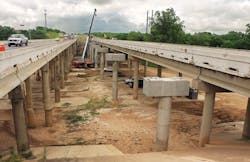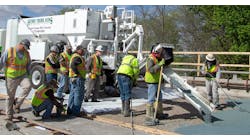By: Susan Fraser, P.E. Contributing Author
Texas State Highway (SH) 71 serves as the primary access route leading to Austin-Bergstrom International Airport (ABIA).
It also is a major roadway for daily commuters from neighboring Bastrop County to the Austin metropolitan area and serves as one of two east/west high-capacity routes for traveling between central Texas and east Texas destinations such as Bastrop and Houston.
Over the last two decades, the population of Austin has grown dramatically from just over 650,000 residents in 2000 to more than 900,000 in 2015, according to U.S. Census Bureau estimates. More than 65,000 motorists per day travel SH 71, making it one of the most congested corridors in the area. This figure is expected to grow to 81,000 by 2036, according to a study by the Texas Department of Transportation (TxDOT).
“Over the last 25 years, the traffic at SH 71 has increased 158%,” said Lisa Rainosek, project manager at TxDOT’s Strategic Projects Division. “Currently, travelers go through multiple red lights in this corridor, leading to long travel times.”
To enhance safety and reduce congestion along this corridor, TxDOT and the Central Texas Regional Mobility Authority, in coordination with the city of Austin, are working together on the SH 71 Express Project, a 3.9-mile limited-access toll road beginning just east of U.S. 183 and ending just east of SH 130. The project includes two new toll lanes (one in each direction), new bridges over Farm-to-Market (FM) 973 and SH 130, as well as ramps between toll lanes and the main lanes of SH 71 and SH 130. In addition, the existing SH 71 roadway between Presidential Boulevard and FM 973 will be widened and the same number of existing non-toll lanes will be maintained. The project also includes improvements such as sidewalks and a shared-use path to make the area more bicycle- and pedestrian-friendly. The enhanced paths will allow for easier pedestrian access to facilities and businesses along FM 973, SH 130 and SH 71, including the airport.
To provide service to commuters as early as possible, the project is being built under the design-build procurement method. The $149 million project, which began in September 2014, is slated for completion in December 2016. To build this fast-track project, TxDOT selected McCarthy Building Cos. Inc. as the design-builder. Lockwood, Andrews & Newnam Inc. (LAN), a planning, engineering and program management firm, was selected as the designer. In addition to McCarthy and LAN, Kimley-Horn and Associates Inc. is providing key design work on the traffic-control phasing, intelligent transportation systems (ITS) and toll systems; CAS Consulting and Services Inc. is assisting with utility relocation and drainage support; Holt Engineering Inc. is providing geotechnical services; and SWCA Environmental Consultants is assisting with environmental support services.
Quick scheduling
To meet the accelerated schedule, the design team broke the project into manageable pieces. Multiple design packages were created for each discipline, including roadway, structures, drainage, traffic control and ITS. A key element in the design process included having various sub-consultants co-located with the design team. This fostered close collaboration, enhanced communication, the sharing of ideas, the development of solutions and coordination between the design-builder and the design-build oversight team. The team also used ProjectWise, a project collaboration and content-management platform, to ensure fast reuse of design files. More than 70 engineers, designers and support staff, working in five different cities, produced as many as 25 different design packages and approximately 140 submittals.
The project team also developed a rigorous quality-control plan with five different entities—an independent engineer, the designer, design-builder, GEC program manager and TxDOT—reviewing the packages to ensure design accuracy and the meeting of technical provisions. Decisions were made early and stakeholder concerns were addressed quickly as design progressed. Weekly coordination, taskforce meetings and regular design workshops enabled the design to be vetted throughout the project.
“The biggest challenge from a design perspective was developing an efficient design in such a short amount of time,” said Larry Zamora, P.E., a senior engineer with LAN and the design manager for the project. “The majority of the design was completed in just nine months.”
Pavement design
Pavement designs were prepared for the SH 71 main lanes, general purpose lanes and FM 973 to perform as required over the design life. Prepared by pavement engineer Tim Martin, P.E., these included flexible designs using TxDOT’s FPS-21 software as well as rigid designs using the AASHTO Guide for Design of Pavement Structures. These designs met the mechanistic and triaxial checks for pavement performance. The effective plasticity index (PI) was specified by TxDOT as the procedure for mitigating expansive clay soils prevalent at the project site in central Texas.
According to the technical provisions for this project, the effective PI of the pavement subgrades had to be verified by a quality acceptance laboratory. PSI, with the aid of a 1.5-ton drill rig, sampled subgrade soils at 1-ft intervals up to a depth of 15 ft in some places along the corridor. PI testing was performed on each soil sample, and a weighted average was calculated for each boring location to verify that the subgrade soils had a PI less than 25. In some areas on FM 973, subgrade remediation was performed to remove soils that had a higher PI than was required. Soil was replaced in this area by a lower PI material, and the weighted PI average was recalculated for verification and acceptance.
After the subgrade materials were in place, and prior to the placement of flexible base material, the effective resilient modulus was verified to determine if the pavement design met the design criteria. A bulk sample of the subgrade was excavated using a backhoe to a depth of approximately 3 ft and delivered to the University of Texas at Arlington to be tested per AASHTO test method T307.
The conventional flexible design consisted of a thin overlay mixture (TOM) for a high-performance surface, a PG Type C surface and Type B base mixture, and a high-quality prime coat underseal. The base layer consisted of an untreated flexible base. A continuously reinforced concrete pavement was specified for the SH 71 main lanes east of FM 973 and included a bond breaker with 6-in. cement-treated base. Overlay options were allowed and are scheduled in year 15. Flexible pavement was specified for general-purpose lanes.
Utility conflicts
The project team navigated several challenges during the design and construction of the toll lanes. Foremost among them was minimizing utility relocations and service interruptions in a corridor with a complex utility network.
“As many as 13 utility companies have significant infrastructure at the intersection of SH 71 and FM 973,” said Jeffrey Billows, PMI, a project director at McCarthy and the construction manager for the project. “We coordinated with each individual utility owner, performed exhaustive field investigations and then worked with our design to accommodate everything.”
To discover potential utility conflicts, the project team generated a 3-D geometric model, developed by DTM Solutions, and visualized the design.
“We developed horizontal and vertical data for every utility, roadway, drainage and structural element in order to generate the required input for the 3-D model,” said Richard Camero, P.E., a roadway design engineer at LAN. “This enabled us to gain a better understanding of the project and helped us communicate with TxDOT and other stakeholders, and also figure out solutions to potential utility conflicts. Using the 3-D model, we identified a toll gantry that didn’t meet the clearance requirements of an existing utility and also adjusted our drainage design along FM 973 to avoid relocating a major telecommunication line.”
Further challenges
Working in the dense SH 71 corridor, especially near a busy airport, provided challenges as well. The project team had to take into consideration holidays and major events when traffic volume would be high in the corridor, such as the University of Texas-Austin football games, Austin City Limits music festival, and the Circuit of the Americas motorsports and entertainment events. To solve this challenge, the team developed a multi-phased traffic-control plan, with an emphasis on maintaining traffic flow through the corridor and minimizing impact to adjacent businesses and ABIA.
Above: The project includes new bridgework over FM 973 and SH 130. Travel time is expected to drop 16% almost immediately upon completion.
Bottom: Contractors negotiated both a crucial traffic corridor and multiple utility owners for the SH 71 job, which had infrastructure in and around the project site.
“Safety was our biggest consideration when we developed the traffic-control plan,” said Floyd Watson, P.E., AICP, project manager at Kimley-Horn. “Throughout the project, a series of traffic switches will occur along SH 71 and FM 973. To perform this task, the contractor will be using temporary pavement, traffic signals, barriers and lane transitions all marked with good signage and pavement markings.”
The team has worked night shifts to set traffic controls and barriers for the following work day. They also have employed smaller pieces of equipment to work in tight spaces, minimizing the need for lane closures. In addition, the team also interfaced with ABIA operations and the Federal Aviation Administration to set equipment and light standards during construction.
Expansive clay soils prevalent in the east Austin area also created challenges for the project team. The plasticity indices of the soils in the project zone ranged from 29 to more than 50, well above the design team’s target for the subsurface conditions.
“To prevent settlement, we required a weighted average of 25 or lower PI,” said Billows. “In places where the PI was too high, we over-excavated and replaced it with a coarse, granular material with low PI. That varied in places along the corridor. In other places where the PI was low, we didn’t have too much material to replace. On the east side of the corridor, we replaced as much as 4-5 ft of existing clay soils to get that weighted average.
“This issue was especially acute under the abutments where the clay was quite soft. We did a settlement analysis and found that the weight of fill compressed the existing soil and was causing an unacceptable amount of settlement. We over-excavated almost 10 ft deep to even out the settlement.”
Fitting in a shared-use path in the tight right-of-way between Presidential Boulevard and FM 973 was another challenge. To accommodate the path, the team developed horizontal and vertical alignments while including other roadway improvements such as pavement widening, bus stops, culverts, earthen channels, curb walls, driveways and driveway culverts. The shared use path also had to be designed to avoid existing/proposed utilities and meet Americans with Disabilities Act criteria.
“We went through multiple design iterations to fit everything in such a constrained environment,” said Zamora. “It was like putting together the pieces of a complex jigsaw puzzle.”
Additionally, the pier-drilling operations on the Onion Creek Bridge widening on eastbound SH 71 had some drilled shafts that had to be cased to prevent collapsing due to the high water levels and the proximity of Onion Creek. A TxDOT Class SS concrete mix with a high slump was used in these shafts. The high-slump mix ensured that when the casing was pulled from the drilled shaft during the concrete placement, the mix had enough workability and plasticity to immediately flow into any voids and to keep a positive head. The Class SS concrete, which was provided by Texas Concrete Materials, had water-reducing admixtures which also aided in the workability of the mix.
In the future
The SH 71 Express Project is anticipated to open to the public in summer 2016, with full project completion in December 2016. Once completed, the new toll lanes will reduce congestion along SH 71, lower costs associated with driving in traffic, and improve travel times for all drivers. Specifically, these mobility enhancements are expected to result in an estimated cumulative savings of approximately $500 million over a 20-year period from reductions in emissions, fuel consumption, vehicle wear and tear, and the value of travel time. Preliminary estimates, according to a 2013 TxDOT study, indicate that the project will reduce travel time by 16% in 2016 and 54% by 2026.
“The fact that Austin is growing rapidly is wonderful,” said Rainosek. “But with that growth, it is vital that our roadways continue to grow with the communities they serve, and SH 71 is a major piece to continue economic development and much-needed accessibility in central Texas.” R&B
About The Author: Fraser is Central Texas Transportation Manager for Lockwood, Andrews & Newnam.




